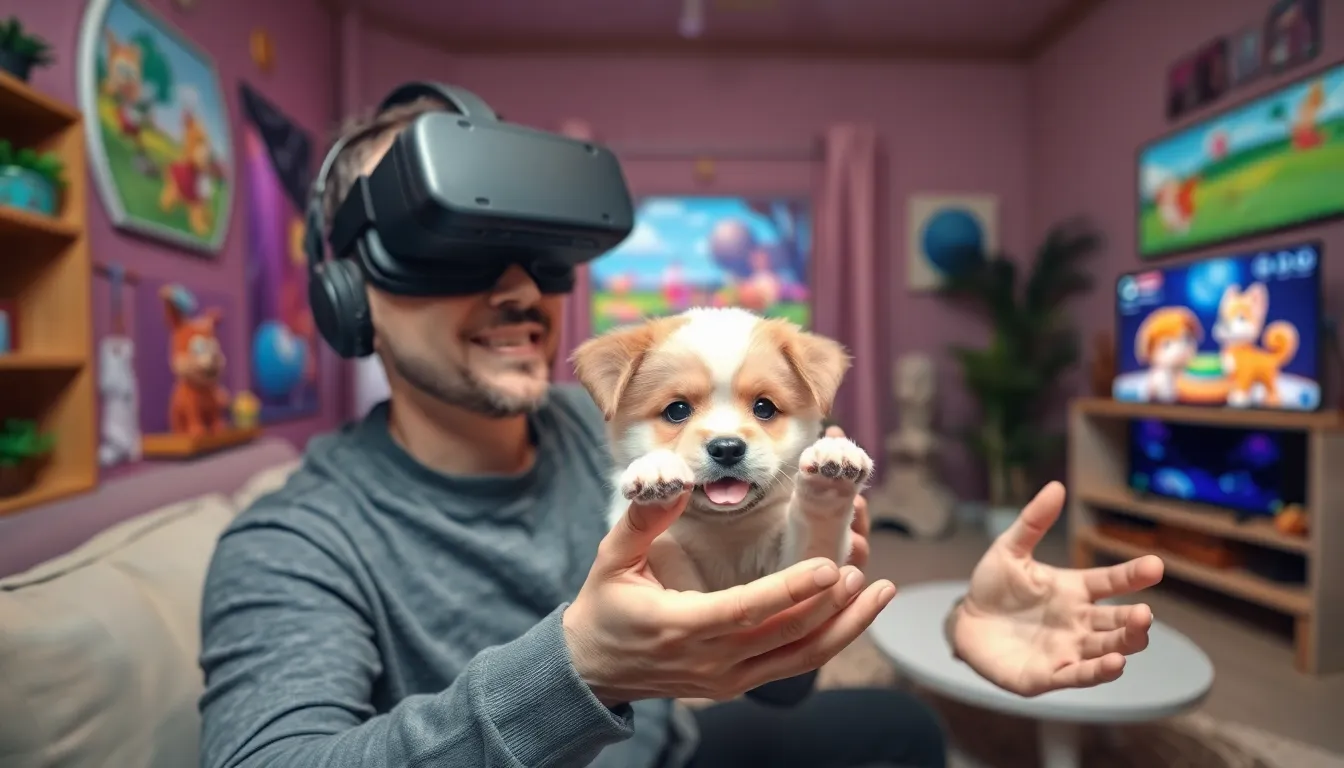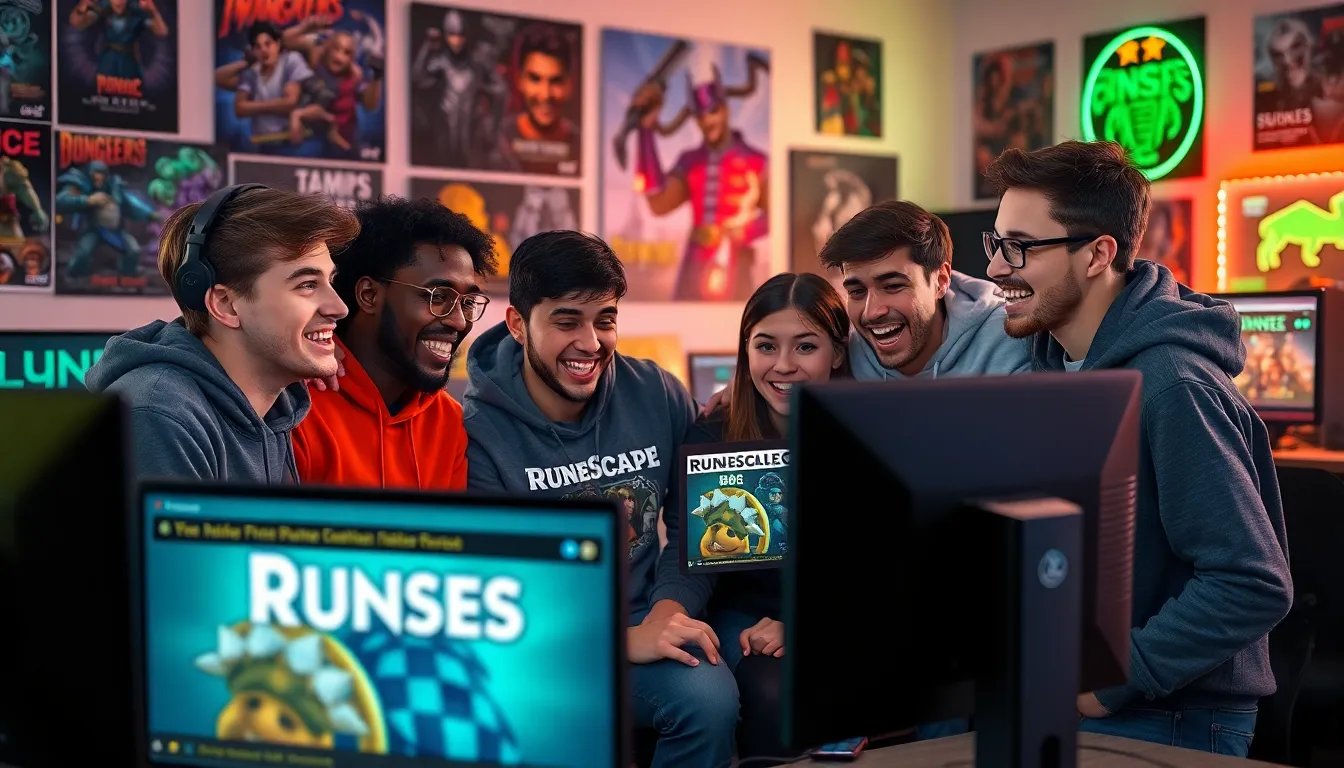Virtual reality has transformed the way people experience gaming, and VR pet games are leading the charge in this innovative landscape. These immersive experiences allow players to bond with virtual pets in a way that feels incredibly lifelike. From playful puppies to exotic creatures, VR pet games create a unique blend of companionship and entertainment that appeals to all ages.
As technology advances, developers are crafting increasingly realistic environments and interactions, making it easier than ever for players to nurture and care for their virtual companions. This growing genre not only satisfies the desire for pet ownership but also offers an escape into fantastical worlds where imagination knows no bounds. Dive into the world of VR pet games and discover how they’re redefining the gaming experience.
Table of Contents
ToggleOverview of VR Pet Games
VR pet games create engaging, immersive environments that simulate pet ownership. Players can care for a variety of virtual pets, including dogs, cats, and more exotic animals like dragons. The emphasis on realistic interactions fosters emotional bonds, making the gaming experience deeply personal.
Key features of VR pet games include:
- Realistic Environments: Developers design lifelike landscapes that enhance gameplay. Players can explore parks, homes, and fantastical worlds while interacting with their pets.
- Dynamic Interactions: Advanced AI enables pets to respond to players in real-time. Behaviors vary based on player actions, creating unique experiences each session.
- Customizable Pets: Many VR pet games allow players to customize their pets’ appearances and personalities. This personalization adds depth and attachment.
- Training and Activities: Players can train their pets, teach tricks, or engage in various activities like playing fetch or solving puzzles, promoting active involvement.
- Social Features: Some games include multiplayer modes, allowing players to interact with friends and their pets in shared spaces. This fosters a sense of community.
These elements together create captivating experiences that appeal to a broad audience, offering the thrill of pet ownership without real-world responsibilities. As developers continue to innovate, VR pet games are likely to become even more sophisticated and engaging.
Popular VR Pet Games

Several VR pet games stand out for their immersive features and engaging gameplay, offering unique experiences for pet lovers.
Game 1: Overview and Features
“Pet Simulator VR” allows players to adopt various pets, including cats and dogs. Players enjoy a customizable experience where they can decorate their living spaces. The game features realistic pet interactions, such as feeding, grooming, and playing, fostering emotional connections. Advanced AI ensures pets display lifelike behaviors, responding to player actions with unique animations. Multiplayer options enable players to visit friends’ virtual homes, enhancing social interaction.
Game 2: Overview and Features
“Neko Atsume VR” reimagines the classic mobile game in a virtual setting. Players set out food and toys to attract cute cats to their gardens. The game emphasizes exploration, with players discovering different cats and collecting items. Beautifully designed outdoor environments encourage relaxation and creativity as players customize spaces. Unique cat personalities and realistic behaviors deepen engagement, making pet care feel rewarding and enjoyable.
Game 3: Overview and Features
“VR Dino Pet” introduces a fascinating twist by featuring dinosaurs as pets. Players raise various dinosaur species, caring for their needs while experiencing an adventurous world. This game combines pet care with action, as players explore dynamic landscapes and engage in thrilling activities like flying or racing. Special training programs enhance pet abilities, creating opportunities for competitive play. Frequent updates keep the game fresh, adding new dinosaurs and environments to explore.
Benefits of VR Pet Games
VR pet games offer immersive experiences that enable engaging interactions between players and their virtual pets. These games create unique opportunities for entertainment, education, and emotional connection.
Enhancing Virtual Interaction
VR pet games enhance virtual interactions by providing players with realistic environments where they can engage with their pets. Players experience lifelike movements, behaviors, and reactions from their virtual companions, fostering a sense of companionship. Advanced AI allows pets to respond dynamically to player actions, creating a more immersive experience. The ability to pet, feed, and train virtual animals not only simulates real-world pet ownership but also deepens emotional bonds. Multiplayer features enable social interactions among players, adding an extra layer of enjoyment and community involvement.
Educational Aspects
Educational aspects of VR pet games enrich the gaming experience while promoting skill development. Players learn essential responsibilities associated with pet care, such as feeding, grooming, and training. Games often incorporate challenges that require problem-solving and critical thinking, enhancing cognitive skills. Additionally, certain titles introduce players to concepts like animal behavior and welfare, deepening their understanding of real-life pet ownership. This blend of fun and learning creates a balanced experience, appealing to parents seeking educational content for their children while maintaining entertainment value.
Challenges in VR Pet Games
VR pet games face several challenges that can impact player experience and satisfaction. Addressing these obstacles is crucial for developers to enhance gameplay quality and immersion.
Technical Limitations
Developers encounter various technical limitations when creating VR pet games. Hardware requirements for VR can be demanding, requiring high-performance systems that not every player possesses. Inconsistent frame rates can cause motion sickness, detracting from the immersive experience. Additionally, limitations in tracking technology can affect how accurately players interact with virtual pets, leading to frustrating gameplay. Network connectivity issues can hinder multiplayer experiences, preventing players from fully engaging in social interactions. Developers must balance graphics quality with performance to ensure a smooth experience across different devices.
Player Engagement
Sustaining player engagement in VR pet games poses challenges. Players may initially find the novelty captivating, but without ongoing content updates, interest can wane. Repetitive tasks can lead to boredom if games lack variety and spontaneity. Developers must incorporate dynamic interactions and meaningful choices to maintain player engagement over time. Implementing rewards systems or new challenges can incentivize continued play. Additionally, understanding the target audience helps developers create content that resonates, ensuring players remain emotionally connected to their virtual pets. Regular feedback and adaptation to player needs play a vital role in fostering long-term engagement.
Future of VR Pet Games
The future of VR pet games holds a wealth of possibilities, shaped by emerging trends and potential developments that enhance player experiences and engagement.
Emerging Trends
Innovations in technology drive several emerging trends in VR pet gaming. Real-time interaction with pets now includes advanced AI algorithms, enabling more realistic behaviors and responses. The rise of cross-platform compatibility increases accessibility, allowing players to engage with VR pet games across different devices. Enhanced social features foster community engagement, facilitating interaction among players through shared experiences and competitions. Additionally, integrating augmented reality (AR) elements might provide deeper immersion, blending the virtual and real worlds for richer pet care experiences.
Potential Developments
Future developments in VR pet games focus on enhancing gameplay depth and interactivity. Developers might explore incorporating biosensing technology, which personalizes experiences based on player emotions and reactions. Building adaptive storylines that change according to player choices can add layers of engagement and replayability. Furthermore, leveraging cloud gaming technology could reduce hardware barriers, allowing a wider audience to access advanced VR pet games. Expanding pet varieties, including mythical creatures and intelligent robots, could lead to more varied gameplay, appealing to diverse player interests.
VR pet games are transforming how players experience companionship and entertainment in the gaming world. With their immersive environments and realistic interactions, these games foster emotional connections that resonate with players of all ages. As technology advances, the potential for more engaging and sophisticated gameplay continues to grow.
The blend of fun and education in VR pet games not only entertains but also teaches valuable skills about pet care. While challenges remain in maintaining player engagement, ongoing innovations promise to enhance the overall experience. The future of VR pet games is bright, with exciting developments on the horizon that will further captivate pet lovers and gamers alike.








